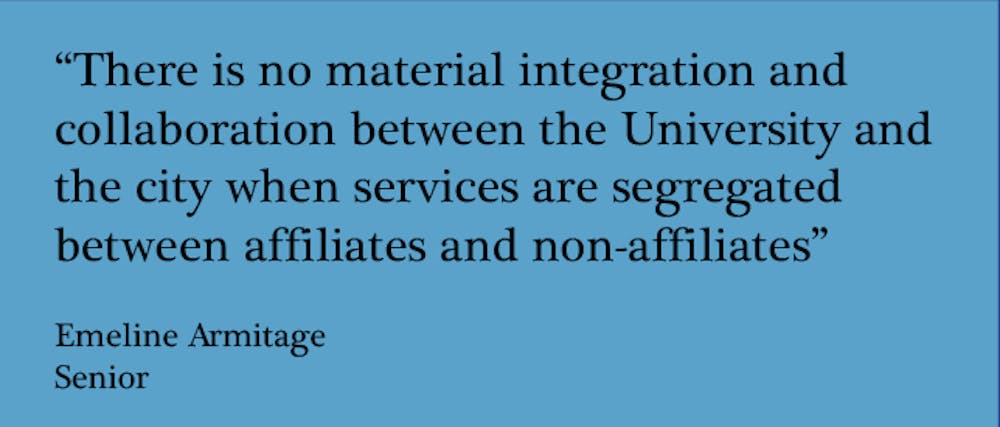The University and President Daniels love to brag about the relationship that Hopkins has with Baltimore and about how Hopkins is an “anchor institution.” Yet the University’s track record — gentrification, low wages, wealth hoarding and the racist scientific experimentation that earned Hopkins the nickname “the plantation” — paint a very different picture of Baltimore-Hopkins relations than the anchor institution narrative does.
In order to live up to its promises and positively affect City residents, Hopkins should start offering its services and opening up affiliate-only programs to non-affiliates. A simple start would be opening the Hopkins shuttle (JHMI) to the public.
Hopkins, which holds assets worth billions, is tax exempt. The fact that the biggest employer in Baltimore is not paying taxes is a huge loss of revenue for the City. Hopkins takes up resources by using city services, gentrifying neighborhoods and not paying its workers a living wage or providing substantial benefits.
The University has lobbied hard in the past against measures that would make the lives of Baltimoreans better (most recently, they unsuccessfully lobbied against the displaced worker protection act, which guarantees job security for subcontracted workers should the contractor change). Opening up the JHMI to non-affiliates would be a small way to give back to the city.
Hopkins students, many of whom do not pay taxes to the City, enjoy the Charm City Circulator for free. The Purple route and the JHMI follow the exact same route from Homewood to the med campus (though the Purple route travels farther) and back.
Allowing non-affiliates to take the shuttle is reciprocating the city services that Hopkins students use and the city services that Hopkins uses in its recruitment PR. The Circulator and Baltimore’s public transportation services are featured prominently in recruitment materials, despite the fact that Hopkins cuts off the City from using its services.
The JHMI would not be used as a replacement for the Circulator or other transportation options. Instead, it would be used as a kind of circulator-express or secondary option when other buses are too crowded, not showing up or broken down.
The City has been cutting routes, raising fares and cutting funding from transportation services, leaving an unreliable, too expensive system for residents. Offering just one more route and one more option would be a small, but not negligible, way of relieving pressure on Baltimore residents frustrated with the transportation system.
Making the JHMI open to the public may require Hopkins to spend money on updating the shuttles. But Hopkins desperately needs to update the shuttles anyway. A ride on the shuttle nearly dislodges one’s skull. They are basically tin shells on wheels violently bouncing up and down St. Paul and North Charles.
Furthermore, it is a disgrace that the JHMI is not accessible to people with disabilities or limited mobility. Getting on the bus requires climbing a few stairs with no option for a wheelchair lift. Hopkins should update the buses, regardless of whether they open them to the public, in order to accommodate disabled students and affiliates.
Hopkins students are constantly told, both by our peers and by the University, to go out and explore the City, to become a part of the City. But that is nigh impossible if Hopkins services such as the JHMI transform non-affiliate city residents into second-class citizens while Hopkins students have access to both city and Hopkins transport. Hopkins version of “getting into the city” means taking the shuttle three times a week to an internship at the med campus and on the weekends taking an Uber down to Federal Hill.
There is no material integration and collaboration between the University and the city when services are segregated between affiliates and non-affiliates (and the President’s Day of Service, while a brilliant PR move, doesn’t count as material integration). This 2-tiered transport system reflects racial disparities: the plurality of Hopkins students are white, while the majority of Baltimoreans are Black.
In order to even begin to live up to its promises to the city of Baltimore, Hopkins must make material, not simply rhetorical, gestures. Opening up the shuttle to non-affiliates would be a great way to begin to undo the two-tiered relationship between Hopkins and Baltimoreans.
Emeline Armitage is a senior International Studies, Latin American studies and Spanish major. She is from Cleveland, Ohio.





